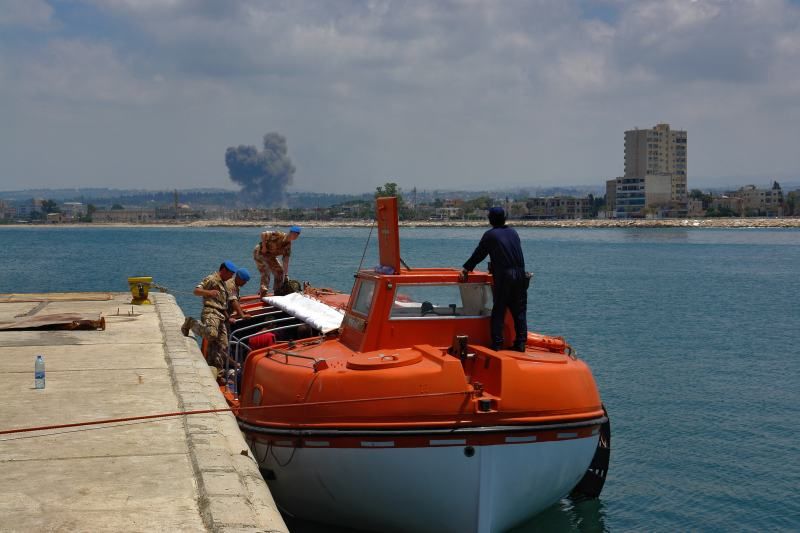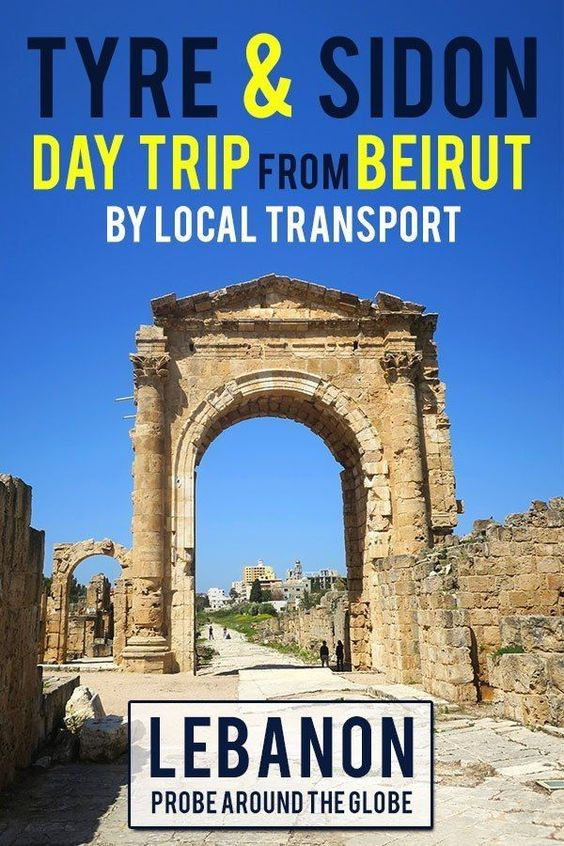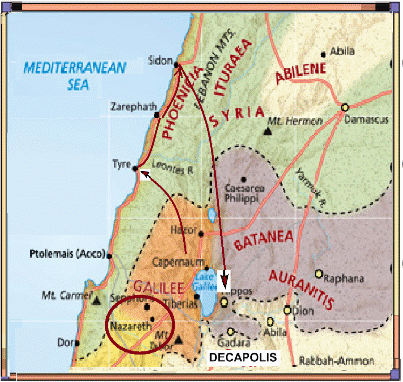
 Pinterest
PinterestEvidences: Prophecies #2
JESUS AND THE PROPHECY OF TYRE
Several of God's literary prophets spoke of pending doom to the particular Canaanites called Phoenicians. Their powerful chief cities of Tyre and Sidon were prophesied over the centuries to have a complete overthrow because of their sins (Isaiah 23: Jeremiah 25; 27; 47; Ezekiel 26-28; Joel 3; Amos 1; Zechariah 9). What eventually happened to them? Some answer, "Nothing; the predictions failed." Others interpret that some of the things happened over centuries but feel that not all have yet been fulfilled. This article considers whether the prophecy of doom has been fulfilled.

 Pinterest
Pinterest
Tyre Lebanon 2006; wiki-media commons. i
In the autumn of 1959 we on the USS Essex were anchored at Beirut, Lebanon. I was afforded an opportunity to visit the Jerusalem-Bethlehem environs which I took advantage of. But I missed an interesting sight: the ruins of Tyre and Sidon. At that time I had read of the 2600-year-old Biblical prophesies for this region and had understood that particularly Tyre would have had no ruins. I thought it should have been obliterated. "Wiped off" the map. As I remembered it, Tyre would "not have been rebuilt" after having being "scraped away into the sea" by its destruction and pillage by the Macedonian conqueror Alexander in 332 BC. I later read that there was a modern Tyre in 1959 that actually had a population of some 15,000 inhabitants.ii The area was under the rule of Shiite Muslim Imams of Southern Lebanon, one of which reported the following:
"The district of Tyre has sixty villages, to which Allah Almighty has given all kinds of beauty. But the rulers of Tyre have deprived Tyre and the surroundings of their rights. Of these sixty villages only a dozen or so have anything that could be called a school or a paved road. Forty villages are without a school. These sixty villages go thirsty in this age of science and the machine, while a river [the Litani] passes them by on the way to the sea. All sixty villages lack electricity. Electricity is the fortune of more privileged districts. .. These sixty villages are deserted, inhabited by old men and women; the young ones have departed to toil in the heat of Africa. Thousands more have come to Beirut, to toil among others of their kind. Tyre itself, the heart of the district, has suffered what no city can suffer. It has become a deformed, ruined place. Everything in it falls short of what a civilised place should be. The government should restore to Tyre its splendor." iii
A PLACE CALLED TYRE TODAY. The 1959 existing Tyre was a "ruined place" but I understood the prophecy to say that Tyre would not be rebuilt at all? Historically, I discovered that the city has been inhabited time and time again.
JESUS VISITED A CITY OF TYRE. If Alexander was supposed to have laid waste Tyre, never to be rebuilt, it is interesting that Jesus visited cities in the first century called Tyre and Sidon. Its Roman ruins exist as proof in 1959. “Then Jesus went thence, and departed into the coasts of Tyre and Sidon” (Matthew 15:21). The Roman ruins date from Jesus' visit. That means that there was still a Tyre after Alexander's Grecian conquest. What is the explanation of "not been rebuilt"? Was the Bible incorrect? Or, had I been incorrectly taught? Is the prophecy yet to be fulfilled?
THE MIDDLE AGES AND THE CRUSADES. There are those that explain away the problem by saying that Alexander was not supposed to completely fulfil total destruction but that we had to wait for the Arabs to do it a thousand years later during the Middle Ages. Indeed, the Crusaders of the Middle Ages built a fine city harbor. So obviously the city had been rebuilt after Alexander. Again, as has been pointed out, there is another modern city of Tyre. With the influx of refugees from the Syrian war zones Tyre is considered a growing metropolis.
JESUS ANALOGY INDICATES IT HAD BEEN FULFILLED. Before Jesus visited Tyre He made an analogy of it to His Jewish audience. "Then began he to upbraid the cities wherein most of his mighty works were done, because they repented not: Woe unto thee, Chorazin! woe unto thee, Bethsaida! for if the mighty works, which were done in you, had been done in Tyre and Sidon, they would have repented long ago in sackcloth and ashes. But I say unto you, It shall be more tolerable for Tyre and Sidon at the day of judgment, than for you. And thou, Capernaum, which art exalted unto heaven, shalt be brought down to hell: for if the mighty works, which have been done in thee, had been done in Sodom, it would have remained until this day. But I say unto you, That it shall be more tolerable for the land of Sodom in the day of judgment, than for thee” (Matthew 11:20-24).
JESUS USES TYRE'S PUNISHMENT AS WARNING TO THE UNREPENTANT. The context corresponds circumstances of Tyre and Sidon with that of the punishment of Sodom and Gomorrha. Jesus uses both Tyre and Sodom to illustrate God's condemnation of sin.
SODOM. Punishment that happened to Sodom had already happened when Jesus taught His condemnation for the Jewish towns of Chorazin, Bethsaida, and Capernaum. The Canaanite Sodom was no more; it was history. Only Sodom's salt ruins existed in Jesus' day as that city of “strewn whitish ash and sulfur balls” according to the first century historian F. Josephus.iv This is obviously a warning to the stubborn Jewish audience. What would this have in common with Tyre and Sidon for Jesus to use them in His lesson? Would not their punishment have already happened as well? Otherwise, what would be Jesus' point?
Someone may question whether Jesus could be pointing out the current Tyre's readiness of mind since when He went there, a Syro-Phonenician woman did demonstrate strong faith and also later there's a congregation established there (Acts 21:4)?
I affirm that Jesus was not speaking of the current inhabitants of Tyre and Sidon but of those that were condemned and punished previously.
The audience would have to have known that something had happened to Tyre and Sidon. The people would have been aware of the glory of the ancient cities. Jesus (according to Matthew's chronology and some gospel harmony timelines) went to Tyre after he used the analogy in Matthew 11:21.v Acts 21 would certainly not have happened yet. An unfulfilled punishment would not have been understood in the mind of his audience.
There were people from Tyre (and Sidon) coming south to Jesus to be healed. "And from Jerusalem, and from Idumaea, and from beyond Jordan; and they about Tyre and Sidon,vi a great multitude, when they had heard what great things he did, came unto him” (Mark 3:8). These were surely Jewish citizens or proselytesvii since Jesus told the Phoenician woman that He was sent "only" to serve Jews and she had to plead with Him for the crumbs from the table.viii Hence, Jesus would NOT have been referring to the current citizens repenting toward Him.
When Jesus speaks of the status of Tyre and Sidon in Matthew 11:20-24, the first verb is in a strong aorist tense; the second verb is likewise aorist. What had happened to them had happened. None of it in the analogy was yet in the future.

Jesus visited a Tyre and a Sidon in the first century.
IN CONCLUSION, rather than the prophecies failing, it behooves us to look analytically at the predictions and determine what actually was prophesied in conjunction with what actually happened to the Phoenicians of Canaan. Sodom had been a real place with real judgment. Jesus referred to its judgment which without question had been consummated. Its future is in the Final Judgment. Likewise, we can conclude that the Tyre and Sidon that Jesus spoke of had received its predicted judgment and their citizens would receive their comparative mercy at the Final Judgment.
.
-- Gaylon West
Editors: Janie Ruth Ward; Mary Lou WestTHROW OUT THE LIFELINE
website
i https://en.wikipedia.org/wiki/Tyre,_Lebanon
ii There were approximately 200,000 inhabitants in the Tyre urban area in 2016, including many refugees. https://en.wikipedia.org/wiki/Tyre,_Lebanon
iii Badawi, Ali Khalil (2018). TYRE (4th ed.). Beirut: Al-Athar Magazine. pp. 46–49. https://en.wikipedia.org/wiki/Tyre,_Lebanon#cite_note-:40-76
iv http://www.amazinghope.net/sodom-and-gomorrah-flavius-josephus-jewish-war/. Josephus was born a couple years after Jesus was crucified but he acknowledged the existence of the ashes of Sodom and Gomorrha's fiery destruction. That it was standing then is also attested by Clement of Rome, contemporary with Josephus; as also that it was so in the next century, attested by Irenaeus, https://www.ccel.org/ccel/josephus/complete.ii.ii.xi.html
v One harmonized timeline version of Jesus' earthly ministry has Jesus' comments on Tyre and Sidon (Matthew 11:20-24 and Luke 7:18-35) following the second Passover. This was before His visit to Tyre and Sidon which is placed in the timeline following the third Passover (Matthew 15:21-28; Mark 7:24-30). https://biblestudylessons.net/NS/harmony/harmonyfr.html
https://biblestudylessons.net/NS/harmony/harmonyfr.html
vi “In our Lord’s time Idumea was practically a part of Judea with a Jewish circumcised population” (George Adam Smith quoted by A. T. Robinson).
vii “Whether these people were non-Jews is unclear as the non-Jewish areas listed also contained Jewish populations. Another group of the time to consider is the Jewish Proselytes.” Brown, Raymond E., quoted in https://en.wikipedia.org/wiki/Mark_3#cite_note- Brown_et_al._603-2
viii 'He answered, “I was sent only to the lost sheep of the house of Israel.” But she came and knelt before him, saying, “Lord, help me.” And he answered, “It is not right to take the children's bread and throw it to the dogs.” She said, “Yes, Lord, yet even the dogs eat the crumbs that fall from their masters' table.” Then Jesus answered her, “O woman, great is your faith! Be it done for you as you desire.”' (Matthew 15:21-26; compare to Mark 7:24-30).

|